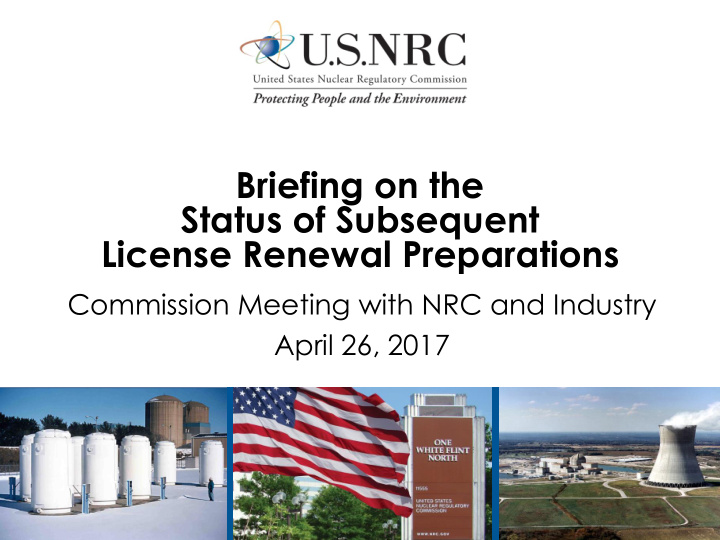



Briefing on the Status of Subsequent License Renewal Preparations Commission Meeting with NRC and Industry April 26, 2017
Agenda • Introduction and Key Messages • Understanding the Regulatory Framework for Subsequent License Renewal (SLR) • Status of SLR Guidance Documents • Overview of SLR Process Optimization • Summary of Changes in SLR Guidance • Status of Confirmatory Research Activities 2
Existing Regulatory Processes Are the Framework of License Renewal 3
Regulations and Processes Ensure Safe Operation • License renewal regulations ensure passive, long-lived structures and components perform intended functions • License renewal application review includes environmental and safety reviews, audits and inspections • Continuous verification of safety through reviews and Reactor Oversight Process 4
License Renewal Framework Adequate for SLR • The principles of license renewal continue to be effective for SLR • Additional focus on the adequacy of aging management programs (AMPs) and activities for the subsequent period of extended operation 5
Staff is Finalizing Regulatory Guidance for SLR • In December 2015, draft SLR guidance documents issued for public comment • In 2016, staff held nine public meetings and addressed public comments • In April 2017, Advisory Committee on Reactor Safeguards full committee meeting completed • Final SLR guidance to be issued July 2017 6
SLR Applications Expected in the Near Future • Peach Bottom Atomic Power Station – SLR application expected mid-2018 • Surry Power Station – SLR application expected early 2019 • Letters of intent useful in helping NRC prepare for anticipated submittals 7
Staff is Optimizing SLR Application Reviews • Identified modifications to optimize review of SLR application. New approach includes: – Increasing the use of portals, telecommunications – Early development of safety evaluation report and environmental impact statement – Streamlining on-site audits – Eliminating redundant inspections • Optimized review of high quality SLR application with no contentions could be completed in 18 months 8
Four Key Technical Issues for Operation Beyond 60 Years • Reactor pressure vessel neutron embrittlement at high fluence • Irradiation-assisted stress corrosion cracking (IASCC) of reactor internals and primary system components • Concrete and containment degradation • Electrical cable qualification and condition assessment 9
SLR Guidance Documents Enable Consistent Reviews of Applications • Generic Aging Lessons Learned for SLR (GALL-SLR) Report (NUREG-2191) ‒ Contains generic aging effects to be managed and appropriate AMPs • Standard Review Plan for the Review of SLR Applications for Nuclear Power Plants (SRP-SLR) (NUREG-2192) ‒ Contains guidance to NRC safety reviewers of the SLR application 1 0
Development of SLR Guidance Involved Rigorous Staff Review • Technical sources used for SLR guidance – Expanded Materials Degradation Assessment – AMP effectiveness audits at plants in the period of extended operation – Relevant domestic and international operating experience – External stakeholder, staff comments 1 1
Refinements to Current Guidance to Support 80 Years of Operation • New GALL-SLR Report AMPs – Fluence Monitoring – High Voltage Insulators • Modified approach to aging management for reactor vessel internals • Modifications to Reactor Vessel Material Surveillance AMP 1 2
Changes Include Revisions to Electrical and Structural AMPs • Expanded Electrical Insulation of Cables AMP from one AMP to three AMPs to address aging of submerged cables at different voltages • Aging management of concrete – Updated for alkali-silica reaction (ASR) – Added further evaluation for irradiation of concrete 1 3
NRC is Prepared to Review SLR Applications • GALL-SLR Report AMPs address technical issues • Plant-specific approaches for a few technical issues • Applicant’s responsibility to evaluate technical issues, develop acceptable aging management methods 1 4
Staff is Ensuring Reactor Pressure Vessel Integrity • Confirming predictive BWRs methods using operating experience (surveillance data) • Assessing embrittlement at higher fluence levels 1 5
Staff is Assessing Effects of Irradiation- Assisted Degradation of Internals • Evaluating impacts of IASCC, loss of fracture toughness, and void swelling • Testing materials at higher irradiation levels Cracking in a PWR baffle bolt 1 6
Staff is Assessing Concrete Degradation • Evaluating effects of ASR on structural performance of concrete • Confirming structural integrity 1 7
Staff is Confirming Structural Concrete Integrity • Evaluating effects of irradiation on concrete structures – Confirming DOE concrete irradiation damage and EPRI concrete structural performance results – Assessing EPRI’s evaluation of susceptible plant configurations – Assessing neutron fluence and gamma dose on structural bio- shield concrete 1 8
Staff is Confirming Adequacy of Cable Condition Assessment Techniques • Evaluating synergistic effects of gamma radiation and thermal exposure in low voltage cables Thermal aging of jacketed cables • Confirming assessment of medium voltage cable submergence qualification 1 9
NRC Demonstrating Readiness to Accept and Review SLR Applications • License renewal framework is basis for SLR • Extensive stakeholder engagement continues • Confirmatory research ongoing for technical issues • NRC ready to accept and review SLR applications 2 0
Acronyms • AMP: Aging Management Program • ASR: Alkali-Silica Reaction • DOE: Department of Energy • EPRI: Electric Power Research Institute • GALL-SLR: Generic Aging Lessons Learned for Subsequent License Renewal • IASCC: Irradiation-Assisted Stress Corrosion Cracking • SLR: Subsequent License Renewal • SRP-SLR: Standard Review Plan for the Review of Subsequent License Renewal Applications for Nuclear Power Plants 2 1
Recommend
More recommend